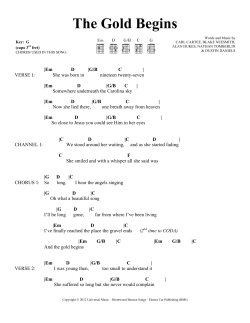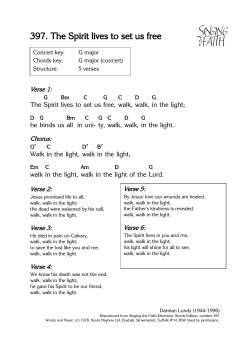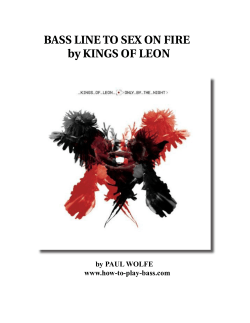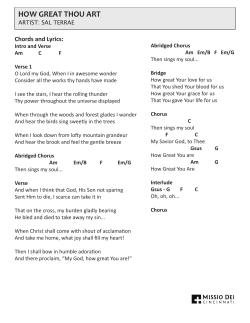
Singing the Words Teacher and Student Objectives
Singing the Words Teacher and Student Objectives Teacher Objectives Teachers will be able to lead students in writing lyrics to verses to three songs. Teachers will be able to identify key elements of lyric writing. Teachers will appreciate connections between lyric writing and demonstrating understanding of other academic areas. Teachers will know where to find further resources on lyric writing. Student Objectives Students will know the key elements of lyric writing. Students will be able to create original verse lyrics that demonstrate their understanding of other subject areas. Students will work collaboratively to write lyrics. Students will exercise key components of creativity, including brainstorming and selecting ideas, synthesizing understanding, and using critical thinking, to edit their work. Students will be able to sing their verses with appropriate volume and clarity. 1 Singing the Words: Lyric Writing in the Classroom PREPARING TO SING: Vocal Warm-Ups In this activity, students will warm up their voices and sing a song together. Background Information Singing creates community in classrooms. It creates safety. It allows students to relax into an activity and to get past self-consciousness, preparing them for creating lyrics together. There’s also little risk of failure with these initial activities. Teachers can build a sense of confidence, success, and group cohesion. Before engaging in lyric writing, lead students in warm-up vocal activities. There are several examples of exercises listed here, but you may have others that you know and like. The order that I approach these warm-ups moves from simply making sound to adding pitch to copying pitch. We also work on breathing technique, articulation, and group cohesion. Spending three to five minutes warming up is a good investment of time. Follow your warm-ups with a song. This song could be a song you will write new lyrics to, or you may choose another song that students will enjoy, and for which there is no particular objective. Again, this small investment of time creates an environment where the following activities are more likely to be successful. Today, we will use “So Many Ways to Be Smart” as a warm up song. Lyrics and chords are found on page 9. For further vocal warm-up resources: http://www.musickit.com/resources/vocal.html http://www.your-personal-singing-guide.com/vocal-warmup.html 2 Singing the Words: Lyric Writing in the Classroom Preparing to Sing: Vocal Warm-ups 3 Singing the Words: Lyric Writing in the Classroom Process 1. Define Lyric: Define what a lyric is (the words to a song.) Give a few examples from different songs (e.g., “Row, Row, Row Your Boat,” “This Land is Your Land,” “Jingle Bells”). 2. Identify Genres: Have students identify the kinds of music (genres) they listen to. Make a list. Answers will probably include country, rap, heavy metal, and pop. Be careful that students do not disrespect each other’s answers. Note that many styles or genres have lyrics; lyric writing is a widespread art form. 3. Identify the Difference Between Chorus and Verse: Most songs have a chorus and a verse. The chorus is the part of the song that is repeated, while verses are usually only sung once. Choruses also give the overview of the song’s subject, and verses fill in details. Choruses usually contain the song’s title, too. 4. Discuss That Lyrics Have Meaning: Have students identify lyrics from a song that they like. Ask students to discuss why they like those lyrics--what makes them memorable? Answers might include: funny, effective rhymes, an original way of saying things, and memorable word play. Discover how the lyrics have personal meaning to them. 5. Discuss the Elements of Lyrics: Identify the elements of lyrics: rhythm, meaning, and rhyme. Refer to the chart from page 28 as appropriate. 6. Analyze the Song. Notice how each of the above elements is manifested in the song you have sung with students. The following questions can guide your analysis of the song, “So Many Ways to Be Smart.” • What is the song about? Multiple intelligences, learning styles • What is the emotion of the song? Cheerful, humorous, upbeat • How many lines are in the chorus? Four • How many lines are in the verse? Four • Is there a rhyme pattern? Yes, AABB • How many syllables are in each line? Eight to Nine “Words make you think a thought. Music makes you feel a feeling. A song makes you feel a thought.” E.Yip Harburg (lyricist for “Somewhere Over the Rainbow” and “Brother, Can You Spare a Dime?”) 4 Singing the Words: Lyric Writing in the Classroom Lyrics in Our Lives: Examining Background Knowledge and Emotional Connections to Songs In this learning activity, students will explore what they already know about lyrics, will be introduced to attributes of effective lyrics, and will analyze the lyrics of song. Background Information Lyrics are the words to songs. They share elements with poetry, but are not necessarily poems on their own. Lyrics connect with music, and their rhythm and overall structure have to fit with melody and rhythm. Lyrics to songs vary with style, emotion, and genre. Some song lyrics are very short; others go on for many verses. Some lyrics repeat throughout a song, while others are heard only once. Originally we can suppose that most music was folk music: improvised, passed down orally, and without any one author. With the advent of writing, printing, and musical notation, individual authors of songs could be identified with their work. Now almost all new songs come directly from specific writers. Whether a writer is working with show tunes, rap, pop music, or classical styles, attention to the words has similar elements, which we will explore in this workshop. Song lyrics have meaning. They convey a message, information, or a story. For some listeners lyrics are very important in their appreciation of a song, while for others different elements are more important. Some studies have shown that girls pay more attention to lyrics and their meaning than boys, who are more affected by the beat, arrangement, and timbre of a song. 5 Singing the Words: Lyric Writing in the Classroom WRITING LYRICS Creating Single Line Lyrics: “I’m On My Way” In this learning activity, students will be introduced to writing lyrics. They will create new lyrics for an existing song, “I’m On My Way,” which is a call and response song. These lyrics are one line long and do not rhyme. In this activity, we focus on elements of rhythm and meaning. Rhythm is of particular importance in this lesson. Students may require help to create lines that fit the metrical pattern. “I’m On My Way” Lyrics I’m on my way… (I’m on my way) Down to Canaan Land… (Down to Canaan Land) I’m on my way… (I’m on my way) Down to Canaan Land… (Down to Canaan Land) I’m on my way… (I’m on my way) Down to Canaan Land… (Down to Canaan Land) I’m on my way, glory hallelujah, I’m on my way. Other verses might include: If you won’t go… (If you won’t go) Don’t you hinder me… (Don’t you hinder me.) If you won’t go… (If you won’t go) Don’t you hinder me… (Don’t you hinder me) If you won’t go… (If you won’t go) Don’t you hinder me.. (Don’t you hinder me) I’m on my way, glory hallelujah, I’m on my way. Other verse lyrics in this song include: Hand in hand… (hand in hand) Side by side… (side by side) Etc. To listen to Bill Harley sing this song, go to the following link: http://www.songsforteaching.com/billharley/imonmyway.htm "Music and rhythm find their way into the secret places of the soul." — Plato 6 Singing the Words: Lyric Writing in the Classroom Verse Writing To Demonstrate Understanding “How Do I Know? I Read It In A Book” In this activity students will write new verses to a song. Each verse will demonstrate their understanding of a specific aspect of the curriculum. One verse will be written together as a large group and then students will work in a small group to create and perform an additional verse. “How Do I Know? I Read It In a Book” Lyrics © Stuart Stotts and Tom Pease, 2003 http://www.cdbaby.com/cd/stottspease2 Chorus D G bm A How do I know? I read it in a book, 3 x D With you. Verse Penguins waddle along the way. Dad stands by the eggs all day. You might think it’s kind of rude; Mom throws up for the baby’s food. Verse G A D We were looking for the gingerbread man. G A D He jumped out of our baking pan. G A D Just like in the books we read. E A We ate him up from his toe to his head. Verse Caterpillars hatch from eggs They crawl around on many legs After metamorphosis You can get a butterfly kiss 7 Verse Dr. Martin Luther King Had a message he would bring He changed the world for you and me With justice peace and liberty Singing the Words: Lyric Writing in the Classroom Process 1) Introduce Lesson In this learning activity, students will work with an existing melody to create new lyrics to a song verse. These lyrics will demonstrate their understanding of a particular content area. For our sample lesson, we will work with meteorology. 2) Play the Song for Students 2) Teach Students about the Background (or Genre) of the Song Stuart Stotts and Tom Pease wrote the song used for this activity, and students wrote the verses. It’s in a folk style, with perhaps a bit of Caribbean influence. It is an effective song to teach students about writing verses because it allows for a wide range of topics and is very straightforward structurally. It’s also fun to sing. 4) Sing the Song with Students a. b. c. d. Play/sing the chorus of “How Do I Know?” twice for students. Ask students if they have any questions about the words. Have students sing the chorus with you. Once students have learned the chorus, sing it with them one more time, encouraging more volume from them. e. Play/sing a verse to the song. Then have students sing it with you. f. Play/sing a second verse to the song. Then have students sing it with you. g. Sing the entire song with students. 5) Analyze the Song What is the song about? Things we learn from books. What is the emotion of the song? Upbeat, happy What is the number of lines in the chorus? Here there are four, three of which repeat. What is the number of lines in the verse? There are four. Is there a rhyme pattern? AABB. Two couplets. A couplet is two consecutive lines that rhyme with each other. How many syllables are in each line? There are 7-10 per line. 6) Brainstorm Content/ideas for Lyrics In a large group, have students brainstorm what they have learned about the content they will be writing a song about. The song will demonstrate their understanding of both lyric writing and the content from the other subject area. The lyrics should demonstrate to other people what they have learned. What information is most important? What arouses their curiosity? What would they want to tell others about 8 Singing the Words: Lyric Writing in the Classroom what they have learned? By focusing on what is most important, students are practicing the reading comprehension skill of determining importance. 7) Write An Original Verse a. Have students first sing melody without the words using “la, la” or “dat-dadat.” Then have students clap the melody so they understand the rhythm of the melody. b. Have students generate first lines that fit the metrical pattern. As students share their lines, write their ideas on the board or a large sheet of paper. c. Once several ideas have been generated, have students choose one line to begin the song with. d. Have students generate a second line that rhymes with the first to create a couplet. A couplet is two lines of equal length that rhyme with each other. Students will share their second lines while you write them on the board. e. Repeat process for second couplet. f. Combine the two couplets to create a verse. Make sure that the two couplets work well together in communicating the important information about the topic. Sing the completed verse. g. Revise the original verse. Have students suggest changes to revise and improve the verse. Changes may address content or lyrical elements (rhyme, rhythm, or meaning). Typically students will need to adjust their verses for better rhythmic fit. They should also check that their lyrics accurately reflect the content. h. Give students the songwriting rubric. Have them review it, and then lead a short discussion encouraging students to keep the items on the rubric in mind when they write their own verse next. 8) Small Group Writing or Individual Writing a. Have students break into groups of 4 or 5. Ask students to sing the melody without the words and then clap the melody. b. Have each group write their own verse on a different aspect of the original topic. It may be helpful to revisit the elements of a successful verse. They will follow the same pattern as the large group: brainstorming ideas, creating lines, and then developing subsequent rhyming lines. c. Have students rehearse their verse. Students may wish to write their verses on flip chart paper so that they can all see the lyrics. 9 Singing the Words: Lyric Writing in the Classroom d. Have students revise their verse. Encourage them to review the rubric and use it during their revision process. 9) Perform/Share Have each small group perform their verse for the rest of the class. 10) Student Assessment Have students assess their verse against a rubric that addresses content and songwriting elements (see page 11). Sing the song again with a few verses. “Scientists have discovered that the same areas of the brain that are involved in processing emotion are also involved in processing memory.” Ruth Weiss (author and science writer) 10 Singing the Words: Lyric Writing in the Classroom 11 Singing the Words: Lyric Writing in the Classroom Supplementary Resources: Bibliography Armstrong, Thomas Multiple Intelligences in the Classroom. Alexandria, VA: ASCD, 2009. Dee Hansen, Elaine Bernstorf, and Gayle M. Stube The Music and Literary Connection. Lanham, MD: Rowman & Littlefield Education, 2004. Jensen, Eric Teaching with the Brain in Mind. Alexandria, VA: ASCD, 2005. Levitin, Daniel. This is Your Brain on Music. NY: Plume/Penguin, 2007. Oliver Sacks. Musicophilia: Tales of Music and the Brain. NY: Vintage, 2008. Page, Nick Music as a Way of Knowing. Portland, ME: Stenhouse Publishers, 1996. Stotts, Stuart. We Shall Overcome: A Song That Changed the World. NY: Clarion Books, 2010. Online Resources www.SingingTheWords.pbworks.com is the wiki for this course. A Stanford study about how musical training improves the ability to process language http://www.sfgate.com/cgi-bin/article.cgi?f=/c/a/2005/11/17/MNGQ9FPODP1.DTL Children’s Music Network; Song resource www.cmnonline.org Stuart Stotts stuart@stotts.com www.stuart.Stotts.com 608.513.0724 12 Singing the Words: Lyric Writing in the Classroom Verse/Lyric Writing Organizer Title: What is the song about? What is the emotion of the song? Write an example of an existing verse: How many lines are in the verse? Is there a rhyme pattern? What is it? (AA, AABB, ABAB, AABCCB) How many syllables are in each line? Possible topics for a new verse: Write one new line: Write the next line, rhyming if necessary: Write two more rhyming lines: Write all four lines together to make a complete new verse: 13 Singing the Words: Lyric Writing in the Classroom Meaning Elements of Lyric Writing Words are true/factual Original Clever way of saying something Funny Poetic Lyrics match emotion of music Rhythm Words fit easily and naturally Accents fit melody Rhyme Unusual words (you and to vs. crew and zoo) Multisyllabic (Lincoln and thinkin’) Internal rhyme Rhyme schemes like AA, ABAB. Illustrate as needed; refer to “Rhyme Scheme Chart.” 14 Singing the Words: Lyric Writing in the Classroom Rhyme Scheme Chart Rhyme scheme is the pattern of rhyming lines in a poem or song. Below are a few examples: AA--Two lines that rhyme with each other(also called a couplet) Oh Susanna, don’t you cry for me. I come from Alabama with a banjo on my knee. A A ABAB--Alternating lines that rhyme with each other There once was a big brown cat That ate a lot of mice He got all round and fat Because they tasted nice. A B A B AABCCB--Six lines that follow this pattern I could while away the hours Conferrin’ with the flowers Consultin’ with the rain And my head I’d be scratchin’ While my thoughts were busy hatchin’ If I only had a brain. A A B C C B Some other possibilities for rhyme schemes in songs include AAAA or AAA. 15 Singing the Words: Lyric Writing in the Classroom Process for Writing Original Verses 1) Teach Curriculum Content for Lesson. 2) Introduce Lesson by explaining what students will be doing 3) Play Song for Students to Hear 3) Teach Students About the Background (or Genre) of the Song. 4) Sing the Song. Play/sing the chorus once or twice for students. Have students join in on chorus. It may be helpful to have lyrics students can see so that they can sing more easily. Lyrics can be projected or written on a board. Play/sing verses. Have students sing once they are familiar with the melody. 5) Analyze the Song What is the song about? What is the emotion of the song? Number of lines in the chorus Number of lines in the verse Is there a rhyme pattern? How many syllables are in each line? (Metrical space) 6) Whole Group Modeling/Writing Brainstorm content/ideas for lyrics 7) Write original verse Revise original verse using rubric? 8) Small Group Writing or Individual Writing Brainstorm Write Rehearse Revise 9) Perform/Share 10) Lesson Closure and Reflection 16 Singing the Words: Lyric Writing in the Classroom
© Copyright 2025










